The Graduate Nursing Project collection includes Doctor of Nursing Practice (DNP) Scholarly Projects and Master's students' non-thesis projects submitted as part of program requirements.
TO
| Title | Creator | Date | Description | ||
|---|---|---|---|---|---|
| 1 |
 |
A Framework for Providers and Nurses: Standardizing Interdisciplinary Patient Rounds Further Improving Collaborative Communication | Searle, Alexia R. | 2020 | Background: When it comes to patient rounds, there continues to be a lack of team communication between medical providers and Registered Nurses. Nationally, only 30% of patient rounds take place with both medical providers and Registered Nurses present. This lack of interdisciplinary communication i... |
| 2 |
 |
Assessing the Feasibility of the Use of the Critical-Care Pain Observation Tool Versus Non-Verbal Pain Scale in the Cardiovascular Intensive Care Unit and Surgical Intensive | Hunt, Sara | 2020 | Background: Accurate pain assessments in critically ill, mechanically ventilated patients can be difficult to obtain. The current pain assessment tool to assess pain in these patients at this medical facility is the Non-Verbal Pain Scale (NVPS). This pain scale uses vital sign variation as a compone... |
| 3 |
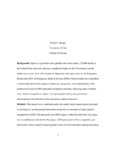 |
Early Septicemia Recognition and Intervention Education for the Pre-Hospital Setting | Grange, Emily S. | 2020 | Background: Sepsis is a persistent issue globally and causes nearly 270,000 deaths in the United States each year, placing a significant burden on the US economy and the health care system. Over 40% of patients diagnosed with sepsis arrive at the Emergency Department (ED) via Emergency Medical Servi... |
| 4 |
 |
Identifying and Addressing Barriers to Timely Admission from the Emergency Department to Medical/Surgical Floor | Dewey, Karen | 2020 | Background: Visits to Emergency Departments (ED) are increasing, which in turn increases the number of admissions from the ED to the inpatient medical/surgical floor. These increases have led to crowding in the ED, resulting in boarding of patients awaiting admission. Boarding in the ED has been lin... |
| 5 |
 |
Implementation of the Surgical Safety Plan | Schelin, Jamee | 2020 | Background: The surgical setting is a high stressed environment where poor communication can lead to fatal errors. Medical errors cause between 44,000 and 98,000 deaths in the USA a year. The single biggest factor underlying these errors is poor communication between health professionals. A large he... |
| 6 |
 |
Implementing Sedation Vacation, Spontaneous Breathing Trial, and Confusion Assessment Method in a Medical Intensive Care Unit | Bryden, Allyson | 2020 | Background: According to the Society of Critical Care Medicine, more than 5 million Americans are admitted to intensive care units (ICUs) annually. Of these admissions, 20%-40% require mechanical ventilation. Patients on mechanical ventilation usually receive continuous sedation medication. Such sed... |
| 7 |
 |
Improving Burn Nursing through Burn Specific Skills Day | Orr, Mindy | 2020 | Background. The American Burn Association recently published a consensus-derived list of eleven standardized burn nursing competencies that nationwide burn unit nursing staff need to maintain. These competencies were published to help direct the educational priorities for burn nursing to ensure the ... |
| 8 |
 |
Improving Inpatient Sleep Quality in the Acute Care Setting | Crockett, Mindy | 2020 | Background: Hospitalized patients are at risk of experiencing an increase in sleep disruptions and a decrease in quality of sleep. Illness, pain, medical interventions, treatments, and the hospital environment can lead to poor sleep. Poor sleep quality can lead to many adverse effects, including ... |
| 9 |
 |
Improving Provider Knowledge and Referral Practice of Patients with Drug Resistant Epilepsy to a Comprehensive Epilepsy Center | Aschkenase, Thérèse Anne | 2020 | Background: Drug Resistant Epilepsy (DRE) occurs when two adequate trials of tolerated and appropriately chosen anti-seizure drugs fail to control seizures, and is associated with excess morbidity and mortality. Surgical treatment of DRE is one of the most underutilized evidence-based therapeutic in... |
| 10 |
 |
Improving Quality and Compliance of Suicide Screening | Stephens, Mary (Katy) Larson | 2020 | Background:Suicide is one of the ten leading causes of death in the United States, with treatment costing the healthcare system over 70 billion dollars. It is essential to properly screen and identify patients most at risk. Additionally, the joint commission identified poor suicide screening or asse... |
| 11 |
 |
Improving Sleep Quality for Critically Ill Patients in a Cardiovascular Intensive Care Unit | Almberg, Lexi | 2020 | Background: Intensive care unit (ICU) care entails the need to continually interact with the patient for medically necessary assessments and interruptions creating increased levels in noise during sleeping hours. Sleep deprivation is harmful to critically ill patients leading to increased hospital l... |
| 12 |
 |
Improving Sleep Quality in the ICU Through a Noise Reduction Time | Drury, Zachary | 2020 | Background:Poor sleep quality is a common problem in the ICU and has been linked to adverse physiologic conditions including altered immune function, neuroendocrine abnormalities, respiratory muscle weakening, and delirium. Excess noise is a risk factor for poor sleep quality among patients. Sleep... |
| 13 |
 |
Increasing Insulin Access Awareness in the Acute Care Setting | Plott, Ashton | 2020 | Background: Between 2012 - 2016, the price of insulin has doubled, and since 2015 hyperglycemia related hospitalizations have increased 120% for those using insulin. Many patients with diabetes (PWD) are unable to afford the monthly cost of insulin and are turning to online trading, bartering, ratio... |
| 14 |
 |
Provider Perceptions of the Tele Critical Care Patient Transfer Process | ZoBell, David | 2020 | Background: Research has demonstrated how interfacility transfer of critically ill patients can be associated with adverse outcomes. A tele critical care (TCC) driven patient transfer process has been instituted by a large hospital system based in the intermountain west, but at this time it has not ... |
| 15 |
 |
A Collaborative Staffing Model in the Urban Community Hospital: Advanced Practice Clinician Integration | Michael, John | 2018 | POSTER |
| 16 |
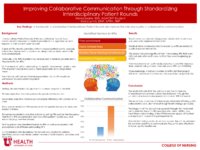 |
A Framework for Providers and Nurses: Standardizing Interdisciplinary Patient Rounds Further Improving Collaborative Communication | Searle, Alexia R. | 2020 | POSTER |
| 17 |
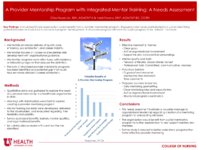 |
A Provider Mentorship Program with Integrated Mentor Training: A Needs Assessment | Lin, Chia-Hsuan; Favero, Heidi | 2021 | POSTER |
| 18 |
 |
A Sleep/Wake Protocol to Reduce Delirium in the CVICU and SICU | Dalton, Anna T. | 2018 | POSTER |
| 19 |
 |
Assessing the Feasibility of the Use of the Critical-Care Pain Observation Tool Versus Non-Verbal Pain Scale in the Cardiovascular Intensive Care Unit and Surgical Intensive | Hunt, Sara; Terry, Kimberly; Kang, Youjeong | 2020 | POSTER |
| 20 |
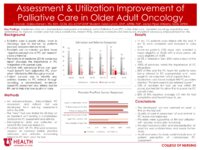 |
Assessment & Utilization Improvement of Palliative Care in Older Adult Oncology | Dailey-Hansen, Amanda; Lynch, Keisa; Piper-Williams, Jaclyn | 2021 | POSTER |
| 21 |
 |
Collaborative ICU Staffing Model | Delgadillo, Jorge A. | 2017 | POSTER |
| 22 |
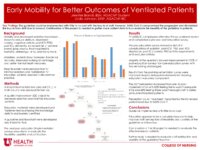 |
Early Mobility for Better Outcomes of Ventilated Patients | Brandt, Jennifer; Johnson, Linda | 2021 | POSTER |
| 23 |
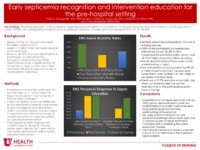 |
Early Septicemia Recognition and Intervention Education for the Pre-Hospital Setting | Grange, Emily; Doyon, Katherine; Sandford, Matthew; Middlemiss, Chris | 2020 | POSTER |
| 24 |
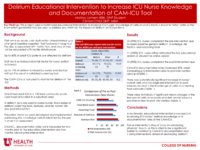 |
Effectiveness of an Educational Intervention to Increase ICU Nurses' Delirium Knowledge and Documentation of the CAM-ICU Tool | Lathem, Mallory | 2019 | POSTER |
| 25 |
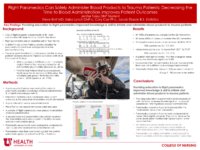 |
Flight Paramedics Can Safely Administer Blood Products to Trauma Patients: Decreasing the Time to Blood Administration Improves Patient Outcomes | Foley, Jenifer | 2019 | POSTER |
